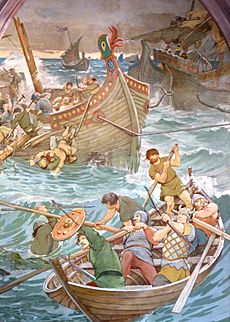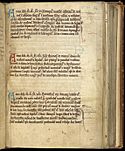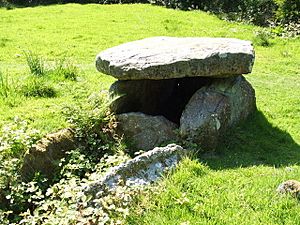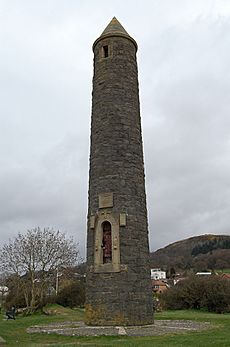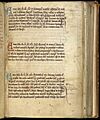Battle of Largs facts for kids
Quick facts for kids Battle of Largs |
|||||||
|---|---|---|---|---|---|---|---|
| Part of the Scottish–Norwegian War | |||||||
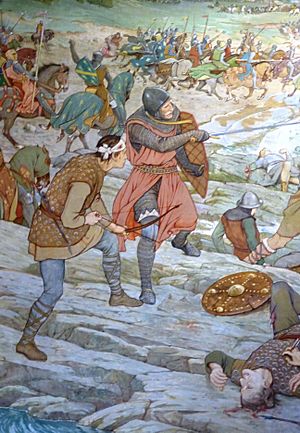 A painting of the Battle of Largs by William Hole, found in the Scottish National Portrait Gallery |
|||||||
|
|||||||
| Belligerents | |||||||
| Kingdom of Scotland | Kingdom of Norway | ||||||
| Commanders and leaders | |||||||
| Alexander of Dundonald | King Haakon IV | ||||||
The Battle of Largs happened on 2 October 1263. It was a fight between the kingdoms of Norway and Scotland near Largs, Scotland. This battle was part of a bigger plan by King Haakon IV of Norway. He wanted to take back control of the western coast of Scotland.
The Scots won this battle. Their young king, Alexander III, used a clever plan. He used long talks to delay the Norwegians until bad weather arrived. A big storm then hit the Norwegian fleet, damaging many ships. This made their soldiers on the coast easy targets. The Norwegians had to quickly retreat. This battle ended Norway's long history of invading Scotland. It also allowed Scotland to become a stronger nation.
For a long time, the Largs area was part of Norway's lands. Local leaders there followed the Norwegian kings. But in the 1200s, two Scottish kings, Alexander II and his son Alexander III, wanted to add this area to Scotland. Alexander III first tried to buy the islands from Norway. When that didn't work, the Scots started military actions. They wanted to take control of all of western Scotland.
King Haakon of Norway reacted by bringing a huge fleet of ships. It reached the Hebrides in the summer of 1263. King Alexander III knew his Scottish forces were much smaller. He decided to use diplomacy to buy time. He hoped to get more soldiers and force the Norwegians to stay until the stormy autumn and winter. By late September, Haakon's fleet was in the Firth of Clyde. The good weather was almost over. When talks failed, Haakon moved his main fleet near the Cumbraes. He was ready to invade Scotland.
On the night of 1 October, a storm hit. Several Norwegian ships were pushed onto the shore near Largs. On 2 October, while Norwegians were trying to save their ships, the main Scottish army arrived. This army had foot soldiers and horse riders. It was led by Alexander of Dundonald. The Norwegians were in two groups. A larger group was on the beach. A smaller group was on a nearby hill.
When the Scots advanced, the Norwegians on the hill ran to join their friends on the beach. The Norwegians on the beach saw them running. They thought their friends were retreating and also fled back to their ships. There was tough fighting on the beach. The Scots then took the hill that the Norwegians had left. Later that day, the Norwegians fought back and took the hill again. The Scots then left the area. The Norwegians got back on their ships. They returned the next morning to collect their dead. As the weather got worse, Haakon's fleet sailed to Orkney for the winter.
Even though it wasn't a huge military victory, the battle led to Norway leaving western Scotland. This ended 500 years of Norse Viking attacks. Scotland then had a good time for almost 40 years. The Battle of Largs led to a big win for Scotland. It ended with Scotland buying the Hebrides and the Isle of Man in the Treaty of Perth in 1266.
Today, the battle is remembered in Largs. There is a monument from the early 1900s. Festivals have also been held there every year since the 1980s.
Contents
Why the Battle Happened
Viking raids started in the British Isles around the late 700s. People from Scandinavia settled on Scotland's western coast even earlier. Norwegian kings claimed this area from the early 1100s. King Magnus Olafsson of Norway took control of the Hebrides and the Isle of Man. But after Magnus died, local leaders ruled these "Southern Isles" for over 150 years.
In the early 1200s, two main groups controlled the islands. One group ruled Mann, Lewis and Harris, and Skye. Another group ruled lands in Argyll and islands like Islay and Mull. These island rulers were part of the Norwegian kingdom. They recognized King Haakon IV of Norway as their overlord.
The early 1200s was a time when both Scottish and Norwegian kings were trying to make their kingdoms stronger. King Haakon of Norway brought peace after some internal fights. He also gained control of the Faroe Islands, Greenland, and Iceland. In Scotland, King Alexander II expanded his power into the Scottish Highlands and Argyll. He also wanted to add the western coast to Scotland.
In 1230, Scottish attacks on the islands forced the Norwegian king to step in. In 1249, Alexander II tried to buy the Isles from Haakon. When that failed, he launched his own military campaign. But the Scottish king died suddenly. His son, Alexander III, was only a boy. So, Scotland faced a difficult time. It wasn't until the 1260s that Alexander III tried to finish what his father had started.
In 1262, after another failed attempt to buy the Isles, Scottish forces attacked Skye. King Haakon responded by planning a huge military trip. It was the biggest force ever to sail from Norway. It reached the Isles in the summer of 1263. Haakon's forces took over some castles and raided the mainland. His fleet then anchored near Arran.
Norwegian and Scottish leaders argued about who owned the Islands of the Clyde. When talks broke down, Haakon sent some ships to raid Loch Lomond. Meanwhile, the main Norwegian fleet moved between the Cumbraes and the Ayrshire coast.
What Happened During the Battle
The main story of the battle comes from Hakonar saga Hakonarsonar. This was written by an Icelandic historian, Sturla Thordarson. It tells the story from the Norwegian side. But it seems to be based on what people saw. A short Scottish account is in the Chronicle of Melrose. This book was written at Melrose Abbey.
On the night of 30 September, a storm hit Haakon's fleet. The saga says a merchant ship lost its anchor and ran aground. The next morning, it and four other ships floated free but were pushed to the Scottish mainland. They ran aground again. Scottish archers soon attacked the crews of these ships. Haakon sent more soldiers ashore, and the Scots ran away. Haakon's soldiers stayed ashore that night. The king himself came ashore the next morning to help save the ships.
The saga says the main Scottish army arrived on 2 October. It had strong horse riders and foot soldiers. The horse riders numbered about 500. They rode good horses protected by armor. Other records also show that many mounted soldiers were present. The Scottish foot soldiers used bows and "Irish axes." They also threw stones. This means some soldiers were slingers. The Chronicle of Melrose calls the Scottish foot soldiers "foot-sloggers of the locality." This might mean they were local men from the nearby areas.
It seems the Scottish army came from the south. King Alexander III was in Ayr, south of Largs, in September. The Scottish commander, Alexander of Dundonald, also had his power base in the south. The Norwegians were split into two groups. A smaller group of 200 men was on a hill, led by Ogmund Crouchdance. The main force of 700 to 800 men, including King Haakon, was on the beach. These numbers might be too high. It was probably closer to a few hundred men on each side.
As the Scots moved towards the Norwegians, Ogmund pulled his men back from the hill. He wanted to avoid being cut off from the men on the beach. When the Scottish front line met Ogmund's men, their retreat became messy. On the beach, King Haakon listened to his men and went back to his ships. The men on the beach saw Ogmund's men running. They thought it was a full retreat and also ran back to their ships. The Norwegian army was scattered. Many were hurt as they rushed back to their ships. Some Norwegians used the beached ships as protection. They fought bravely against many Scots. This shows that some Scottish horse riders fought on horseback. The lost ships and supplies on the beach were important in Haakon's choice to leave the area.

The saga says the Scots then left the beach. They gathered on the hill that Ogmund's men had left. Small fights continued with arrows and stones. Before nightfall, the Norwegians made one last strong attack. They forced the Scots off the hill. Then they calmly went back to their ships. On the morning of 3 October, the Norwegians came ashore. They collected their dead and burned their damaged ships.
For several days, Haakon's forces stayed near Arran. After meeting up with ships that had raided Lennox, Haakon's entire force sailed to the Hebrides. At Mull, he gave land to some of his Norse-Gaelic allies. By the end of October, the Norwegian fleet reached Orkney. In mid-December, the Norwegian king became sick and died at the Bishop's Palace. He was buried for a short time in St Magnus Cathedral.
What Happened Next
The Norwegian story said their campaign was a success. But in reality, it didn't achieve its goals. Haakon just sailed to Orkney to spend the winter. He got sick and died there before he could restart his plans. The campaign had started too late. The Scottish king had successfully delayed talks. This worked to his advantage. As summer turned to autumn, Alexander III made his forces stronger. Haakon's fleet was left to face bad weather.
In the end, Scotland successfully defended itself. Many of Haakon's allies from the Isles didn't fully support him. Within months of the failed campaign, Norway sent people to talk about peace. Alexander III took this chance to punish those who had helped Haakon. By the end of the year, the people of the Hebrides and Mann had to accept Scottish rule.
In 1266, almost three years after the battle, Scotland and Norway agreed to peace terms. On 2 July 1266, the Treaty of Perth was signed. The Hebrides and Mann were given to the King of Scots. In return, Scotland would pay Norway each year. Norwegian rule over the Hebrides never returned. Scotland eventually stopped paying Norway. The treaty also meant Scotland accepted Norwegian rule over Orkney and Shetland.
Why the Battle Was Important
Later historians have called the Battle of Largs a great Scottish victory. Its long-term effects were much bigger than the actual fighting. Only a small part of the Norwegian fleet was involved. Haakon planned to keep fighting after wintering in Orkney. But he got sick in the cold, wet climate and died. His illness might have been caused by the stress of the long campaign. The long talks that slowed his invasion also helped seal his fate.
After Haakon's death, his son, King Magnus Haakonarson, signed the Treaty of Perth. This happened three years after the battle. It gave Scotland's western coast to Alexander III for a yearly payment. This agreement became permanent. But Scotland eventually stopped paying Norway when Norway had its own civil wars.
Many Scottish records from this time were lost during later wars. But historians today see the Battle of Largs as very important. It marked the end of hundreds of years of Norse invasions. The battle also affected clan history. Families like the Boyds, Cunninghams, and Muirs point to their part in this battle. It helped them get land in Ayrshire. For the Boyd family, their motto "Confido" (I Trust) came directly from Alexander III at Largs. The king trusted Boyd's group to keep the Norwegians off Gold Berry Hill.
How the Battle is Remembered
On 12 July 1912, a new stone tower was built in Largs to remember the battle. It is called "The Pencil." This 70-foot-tall, pencil-shaped tower is made of stone blocks. It was designed by James Sandyford Kay. The tower was made to look like old Irish round towers. People wrongly thought these towers were built to fight Vikings. The Pencil has been a protected building since 1971. It stands about 1 mile south of Largs, overlooking the local marina.
The monument marks the traditional battle site. But it is probably not where the actual battle happened. Its wrong location might be because old graves were found nearby. These included ancient tombs and burials. Nearby Bronze Age standing stones might have been thought to be memorials for fallen warriors. An ancient tomb was also linked to the battle. This led to the wrong idea that the battle happened in two nearby parks.
The likely place of the hill where the Norwegians and Scots fought is not marked. It is now surrounded by houses. A 19th-century monument called "The Three Sisters" stands there. The Battle of Largs site was looked at for a list of important Scottish battlefields. But it did not meet the requirements to be included.
Every autumn since 1981, Largs hosts the Largs Viking Festival. This festival celebrates the battle and helps bring tourists. A re-enactment of the battle happens at The Pencil during the festival. The battle is also shown in one of William Hole's large paintings. You can see it in the foyer of the Scottish National Portrait Gallery.
Images for kids



